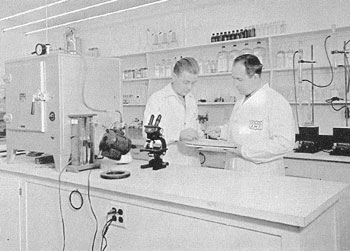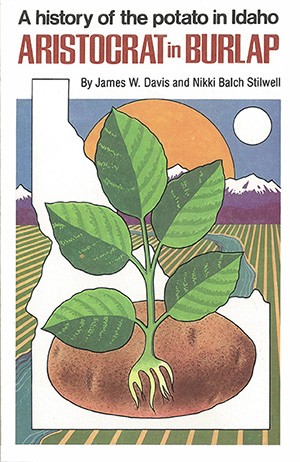 Ray Dunlop, left, developed the frozen french fry for Simplot.
Ray Dunlop, left, developed the frozen french fry for Simplot.
Eager to increase supply capability, the U.S. Quartermaster Corps encouraged the building of an onion dehydration plant and "Jack" Simplot chose a site south of Caldwell adjacent to the onion growing area.
Onions were dried in direct-fired dehydration tunnels using oil as the source of heat. Hot air and products of combustion from the large burners were blown into the tunnels over the exposed surfaces of the minced onions, which were spread out on wood-slatted dehydration trays. The trays, in turn, were stacked on transfer cars and pushed by hand on rails. As a car of freshly-peeled-and-cut onion pieces entered one end of the tunnel, a car of completely dehydrated onion chips or flakes emerged from the other. The tunnels operated 24 hours a day on three shifts, each burner roaring like a small hurricane.
Dehydrated onions were a highly satisfactory product. They reconstituted well and retained the tangy flavor of the Sweet Spanish variety grown in the area. Under forced draft, the burners were clean and a slight sulphur content in the oil provided sulphur dioxide, which acted as a preservative.
The Army was also eager to lighten the load of potatoes they were shipping to the far corners of the world. They approached Simplot in 1942 and asked him to make some experimental runs on diced Idaho potatoes to determine if the same technique used on onions would yield a satisfactory product.
The tests met government specifications, and the process of greatly expanding the Caldwell plant to produce dehydrated potatoes began. Simplot also constructed a dehydrator in Blackfoot and one at Bakersfield, California.
Because dehydrated potatoes were so successful from a logistical standpoint, American servicemen were overexposed to the product in Army and Navy mess halls. Along with powdered eggs and dry milk, dehydrated potatoes came out of World War II with a bad name.
In the meantime, under the auspices of the United States Department of Agriculture, experimentation was proceeding on a powdered, mashed potato product based on an English process. Scientists had discovered that potato cells will separate from each other as complete units when the moisture content of a mixture of mashed, cooked potatoes is sufficiently low. These individual potato cells can then be further dried, preserved for a considerable period of time, and reconstituted by the addition of hot or boiling water. This process developed into a product known as instant mashed potatoes or potato granules.


 Ray Dunlop, left, developed the frozen french fry for Simplot.
Ray Dunlop, left, developed the frozen french fry for Simplot.